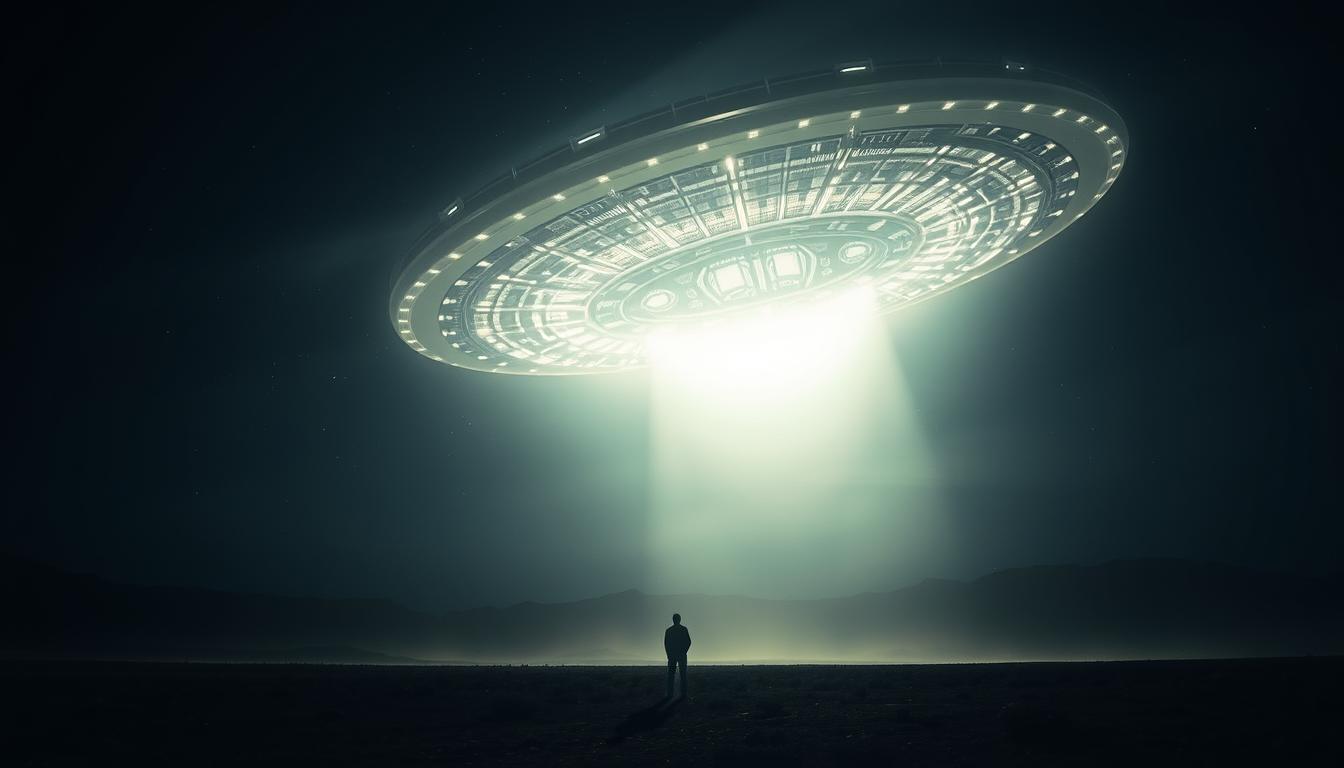For decades, mysterious sightings in the sky have captured public curiosity. Today, the term Unidentified Aerial Phenomena (UAP) has replaced older labels, reflecting a shift toward scientific investigation. Unlike past speculation, modern research focuses on data-driven analysis.
In 2022, NASA formed an independent study team to examine these occurrences. Their goal? To bring transparency and scientific rigor to a topic long clouded by myths. The team’s 2023 report emphasized better data collection methods, aiming to separate fact from fiction.
Beyond curiosity, UAP research ties into national security and aviation safety. Governments worldwide now prioritize understanding these phenomena. This article explores historical cases, recent findings, and the challenges scientists face in unraveling the mystery.
Key Takeaways
- UAP is the modern term for unexplained aerial sightings, studied with scientific methods.
- NASA’s 2022 team aimed to improve data transparency and analysis.
- The 2023 report highlighted the need for advanced data collection tools.
- Research impacts airspace safety and national security.
- Historical cases and government efforts shape today’s understanding.
What Are UAPs? Unpacking the Terminology
Language shapes perception, especially when discussing mysterious aerial events. Over time, labels like “flying saucers” and “UFOs” have given way to the more precise term Unidentified Aerial Phenomena (UAP). This shift reflects a commitment to scientific rigor over speculation.
From UFOs to UAPs: Evolution of the Term
The U.S. Air Force coined “UFO” in 1947 during Cold War-era investigations like Project Blue Book. Back then, reports often mixed military secrets with public curiosity. Today, “UAP” broadens the scope to include phenomena underwater or across multiple domains—dubbed “transmedium” encounters.
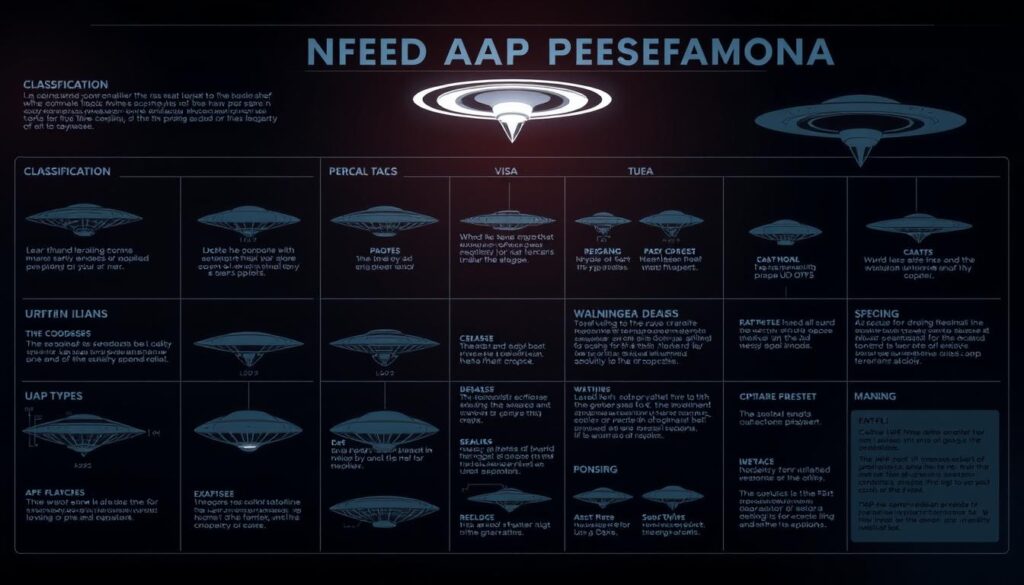
In 2020, the Pentagon adopted “UAP” to reduce stigma and encourage pilots to report sightings. NASA’s 2023 report reinforced this, stating: “Neutral language fosters credible data collection.” The All-domain Anomaly Resolution Office (AARO) now leads U.S. efforts to analyze these cases.
Why the Shift in Language Matters
Words influence how we interpret mysteries. “UFO” carried sci-fi baggage, while “UAP” signals scientific inquiry. Key impacts include:
- Better reporting: Pilots and witnesses are more likely to come forward.
- Broader research: Studies now include radar, satellite, and oceanic data.
- Public trust: Governments aim to replace conspiracy theories with transparency.
As terminology evolves, so does our understanding of what’s truly in the skies—and beyond.
A Brief History of UAP Sightings
Ancient texts and artworks reveal puzzling accounts of celestial phenomena. These records, often dismissed as myths, share striking similarities with modern UAP sightings. From medieval Europe to imperial China, unexplained events sparked both wonder and fear.
Early Accounts: Mysteries in the Sky Before the 20th Century
In 1561, residents of Nuremberg witnessed a “celestial battle” with strange shapes in the sky. A woodcut from the era depicts discs and crosses mid-air—details eerily familiar today. Centuries earlier, Chinese scholar Shen Kuo wrote of a glowing “pearl” object in 1088, darting unpredictably.
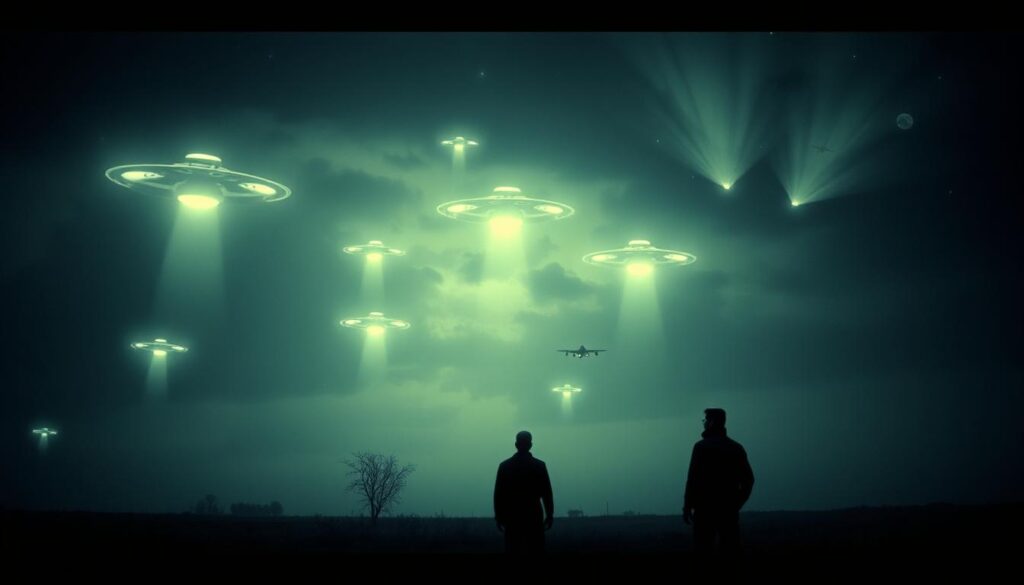
The 1896–1897 “mystery airship” wave swept America. Newspapers reported metallic crafts with bright lights, though no known technology matched the descriptions. While some were hoaxes, many witnesses—including police and scientists—gave credible testimonies.
The 1947 Wave and the Birth of Modern UAP Culture
Pilot Kenneth Arnold’s 1947 sighting of nine crescent-shaped objects near Mount Rainier changed everything. His term “flying saucers” stuck, igniting post-WWII fascination. That same year, the Roswell incident fueled theories of government cover-ups, blending Cold War paranoia with sci-fi imagination.
Key turning points emerged:
- 1952 Washington, D.C. flap: Radar tracked unknown objects over the Capitol, prompting Air Force briefings.
- Military involvement: Projects like Sign and Grudge sought explanations, often amid secrecy.
- Pop culture influence: Films and books shaped how people described encounters, from “little green men” to sleek crafts.
Unlike 19th-century airship tales, postwar reports often came from trained observers—pilots, astronomers, and radar operators. This shift lent credibility to the phenomenon, pushing governments to investigate seriously.
Notable UAP Incidents in the United States
The United States has witnessed some of the most debated aerial mysteries in history. From military encounters to civilian reports, these cases blend intrigue with unanswered questions. Here, we examine three pivotal events that shaped modern understanding.
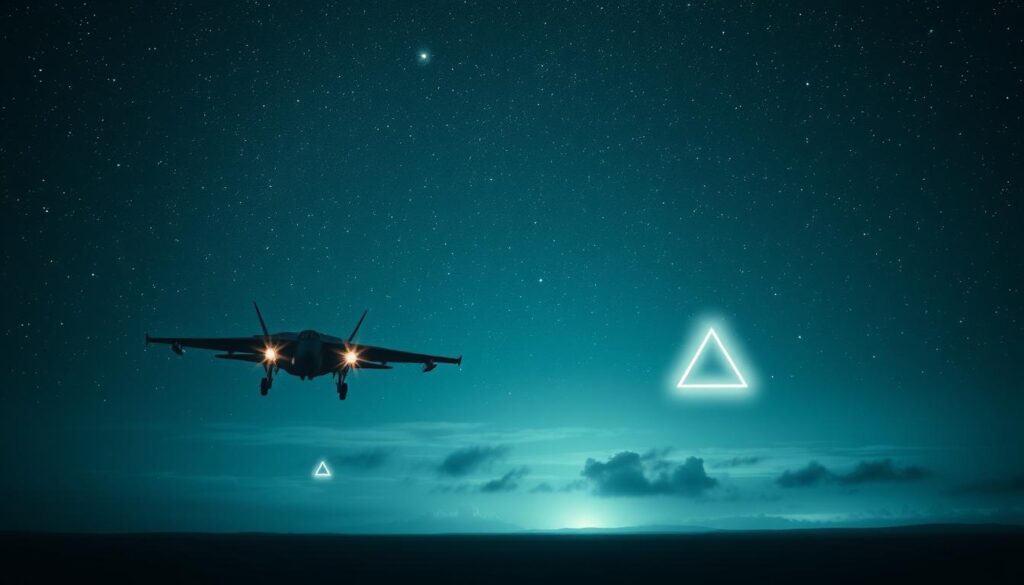
The Roswell Incident: Fact vs. Fiction
In July 1947, a rancher discovered strange debris near Roswell, New Mexico. Initial Army press releases claimed a “flying disc” recovery, later retracted as a weather balloon. Project Blue Book archives reveal the object was likely a nuclear-test surveillance device, yet conspiracy theories persist.
| Roswell Theory | Evidence | Status |
|---|---|---|
| Extraterrestrial Craft | Witness accounts of metallic debris | Debunked by NARA (1994) |
| Military Experiment | Mogul Project balloon records | Most plausible |
The 1952 Washington, D.C. Flap
Radar operators at Andrews Air Force Base tracked unknown objects over the Capitol in July 1952. Jets scrambled, but pilots saw nothing visually—until later that night. “The blips moved at impossible speeds,” recalled an Air Force technician. Declassified documents confirm the objects disrupted commercial air traffic.
Recent Pentagon UAP Videos
In 2020, the Pentagon released three now-famous videos: “GIMBAL,” “GOFAST,” and “FLIR.” Navy pilots described objects defying physics, like the tic-tac-shaped craft in the 2004 Nimitz encounter.
“It accelerated like nothing I’ve ever seen—no exhaust plume, no wings,”
testified Commander David Fravor.
The All-domain Anomaly Resolution Office (AARO) now leads investigations, urging transparency. Public reactions range from skepticism to calls for deeper scrutiny of government archives. While mysteries remain, these incidents underscore the need for rigorous analysis.
NASA’s Role in UAP Research
NASA has taken a groundbreaking step by applying scientific rigor to unexplained aerial events. In 2022, the agency assembled a 16-member independent study team to analyze data free from stigma. Their mission? To replace speculation with evidence.

The 2022 UAP Independent Study Team
Collaborating with the Department of Defense, NASA’s team included astrophysicists, oceanographers, and AI specialists. “This isn’t about aliens—it’s about airspace safety,” stressed associate administrator Nicola Fox. Their tools ranged from satellite feeds to machine learning, aiming to filter out misidentified drones or weather balloons.
Key Findings from the 2023 Final Report
The team’s 2023 report urged standardized global reporting and crowdsourced mobile apps for public sightings. Top recommendations included:
- Deploying advanced sensors to capture high-resolution data.
- Using AI to distinguish mundane objects from true anomalies.
- Fostering open dialogue to combat decades of stigma.
Unlike Cold War-era studies shrouded in secrecy, NASA’s approach prioritizes transparency. As Fox noted, “Sunlight is the best of disinfectants.” The findings mark a turning point—from conspiracy theories to credible science.
Government Investigations and Declassified Records
Government agencies have long investigated mysterious aerial events, leaving behind a trail of declassified documents. These records offer glimpses into official efforts to explain the unexplainable—from Cold War-era projects to modern transparency initiatives.

Project Blue Book and Its Legacy
The U.S. Air Force’s Project Blue Book (1952–1969) remains the most extensive public study of aerial phenomena. It analyzed 12,618 cases, labeling 701 as “unidentified.” Critics argue Cold War tensions skewed conclusions, with many cases hastily attributed to Soviet technology or atmospheric effects.
| Project Blue Book Findings | Number of Cases | Common Explanations |
|---|---|---|
| Identified | 11,917 | Weather balloons, aircraft, stars |
| Unidentified | 701 | Insufficient data, anomalous motion |
Declassified files reveal internal debates. A 1966 memo admitted: “Some cases defy conventional analysis.” Today, researchers scour NARA’s Record Group 615 for overlooked clues in these decades-old reports.
The All-domain Anomaly Resolution Office (AARO)
Established in 2022, the AARO represents a paradigm shift. Unlike Blue Book’s air-focused approach, it tracks anomalies across air, sea, space, and even “transmedium” zones. Its public-facing portal encourages military and civilian reports, aiming to reduce stigma.
Key AARO mandates include:
- Declassifying historical documents for public review.
- Using AI to correlate sightings with satellite or radar data.
- Addressing national security risks posed by unidentified objects.
For those seeking primary sources, NARA’s UFO/UAP archives offer digitized files. Persistent FOIA requests continue to unveil once-classified materials, proving truth-seeking is far from over.
Scientific Perspectives on UAPs
Science offers logical explanations for many unexplained aerial events. While some sightings remain mysteries, most stem from identifiable sources. Researchers emphasize the need for calibrated tools and unbiased analysis to separate anomalies from illusions.
Natural Phenomena Often Mistaken for UAPs
Many reports trace back to rare but documented natural phenomena. A 1979 CUFOS study found fewer than 1% were hoaxes—most resulted from misidentification. Common culprits include:
- Ball lightning: Glowing orbs that appear during storms.
- Lenticular clouds: Lens-shaped formations resembling discs.
- Satellite re-entries: Burning debris creating bright streaks.
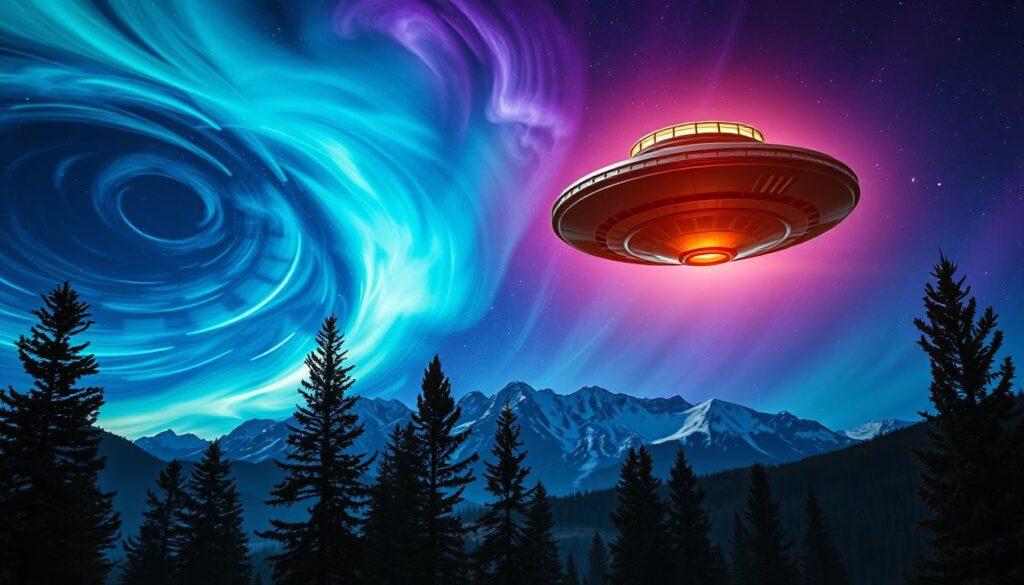
Fata Morgana mirages also distort distant objects, bending light to create false shapes. These optical effects explain many historical “sky battles” and modern radar blips.
The Challenges of Studying Unidentified Aerial Phenomena
Military videos often suffer from sensor limitations. Parallax effects can make ordinary objects seem to defy physics. The 1968 Condon Report concluded that extraterrestrial links lacked evidence, urging focus on terrestrial causes.
NASA’s 2023 study highlighted the need for multidisciplinary research. Combining astrophysics, meteorology, and AI could filter out false positives. As one researcher noted, “Better data beats better speculation every time.”
UAPs in Popular Culture and Media
From blockbuster films to viral tweets, mysterious aerial phenomena have fueled endless speculation. The line between fact and fiction often blurs as entertainment and social media shape public understanding. This section explores how pop culture frames these mysteries—and why critical thinking matters.
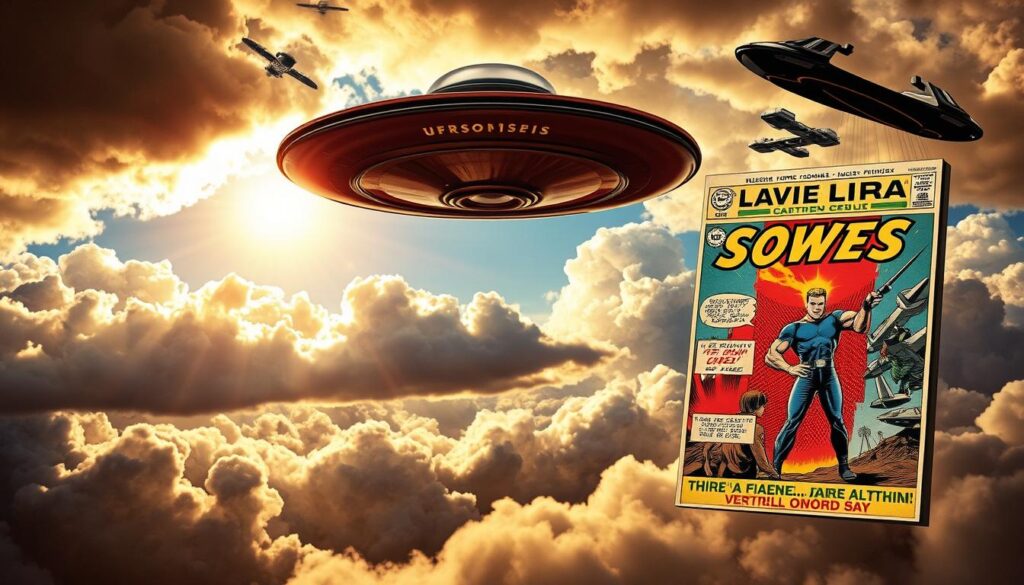
How Movies and TV Shape Public Perception
Shows like The X-Files and films like Independence Day turned UFOs into cultural icons. These stories often mix real reports with sci-fi fantasy, creating lasting myths. A 2021 UCLA study found that 63% of people who believe in government cover-ups cite entertainment as their primary influence.
Documentaries like The Phenomenon take a different approach. They present declassified footage and expert interviews, aiming for credibility. Yet even these can fall into sensationalism, amplifying unverified claims for views.
The Impact of Social Media on UAP Discourse
Platforms like TikTok and Reddit have revolutionized how sightings spread. Eyewitness accounts now go viral within hours, often without verification. Communities like r/UFOs dissect every pixel of blurry videos, sometimes spotting patterns where none exist.
Three key issues emerge:
- Misinformation spikes: Clickbait farms exaggerate mundane events for ad revenue.
- Echo chambers: Algorithms reinforce beliefs by showing like-minded content.
- NASA’s counter-efforts: Their 2023 outreach campaign uses scientists to debunk viral hoaxes.
“Social media turns unknowns into certainties overnight,”
notes Harvard researcher Dr. Sarah Park. Without context, a weather balloon can become an “alien probe” in just a few shares.
Debunking Common UAP Myths
Many aerial mysteries have simple explanations once investigated thoroughly. From optical illusions to deliberate fakes, separating fact from fiction requires critical thinking and evidence.
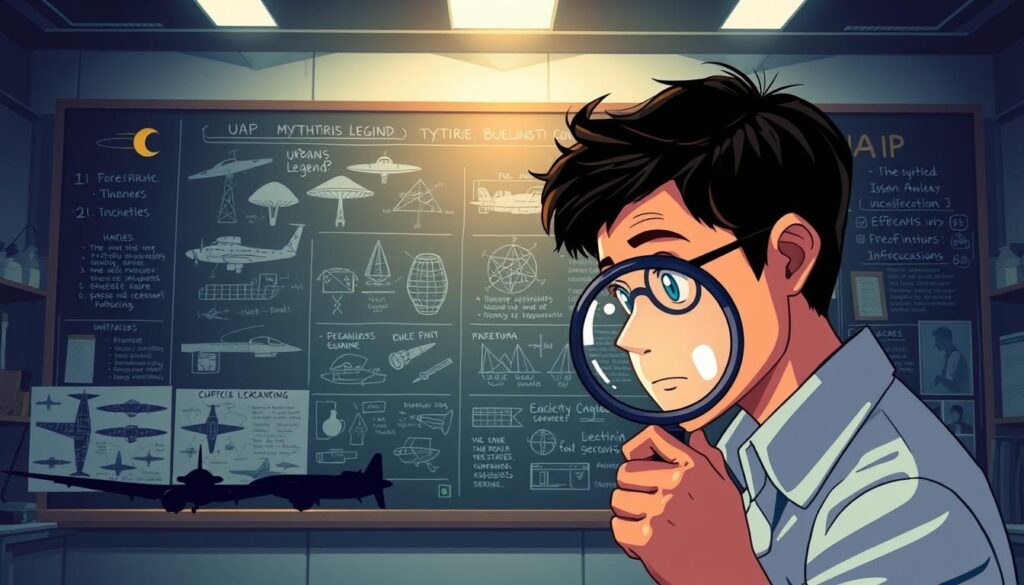
Hoaxes and Misidentifications
The 1995 “alien autopsy” film fooled millions before being exposed as special effects. Similarly, 1950s contactee George Adamski claimed Venusian encounters—later debunked as altered photos.
Even credible cases often have mundane answers. The 1976 Tehran UFO incident was identified as Jupiter after astronomers analyzed flight paths. Common misidentifications include:
- Military tests: Stealth drones or experimental aircraft
- Pareidolia: Seeing faces or shapes in random patterns
- Confirmation bias: Interpreting vague evidence to fit beliefs
Why Extraterrestrial Theories Lack Proof
The Fermi Paradox questions why we haven’t found alien life despite the universe’s vastness. SETI’s Jill Tarter notes: “Extraordinary claims require extraordinary evidence—we simply don’t have it.”
Occam’s razor favors simpler explanations. Before invoking aliens, scientists check for:
- Atmospheric anomalies
- Human-made objects
- Sensor malfunctions
While UAP myths persist, most dissolve under scrutiny. As astrophysicist Carl Sagan said, “The absence of evidence isn’t evidence of absence—but it’s not evidence either.”
Global Perspectives on UAPs
Around the world, governments and researchers have documented unexplained aerial events with striking similarities. While the U.S. dominates discussions, cases from Europe, South America, and Asia reveal shared patterns—and varied approaches to transparency.

Notable Cases Beyond American Borders
In 1980, the Rendlesham Forest incident became Britain’s most famous case. U.S. military personnel stationed in Suffolk reported a triangular craft with hieroglyphic-like markings. Declassified memos confirmed high-level interest, though officials later suggested it was a lighthouse beam misinterpreted.
Brazil’s 1986 Operação Prato involved hundreds of witnesses in the Amazon. The Air Force tracked glowing objects that allegedly caused burns and paralysis. Files released in 2017 showed pilots pursued the phenomena for months, labeling them “non-terrestrial” in classified reports.
How Governments Handle the Mystery
France’s GEIPAN, launched in 1977, stands out for public access. It publishes 90% of its findings online, including radar data and witness sketches. Contrast this with China’s classified research or Canada’s open-but-sparse archives.
- Russia: 2009 Navy declassified Soviet-era reports, citing “objects demonstrating advanced technology.”
- United Nations: A 1978 proposal to create a global UAP task force stalled but inspired later collaborations.
“The sheer volume of international reports suggests this isn’t just a cultural phenomenon—it’s a persistent global question,”
noted Dr. Jacques Vallée, a French astrophysicist. From lighthouses to jungles, these cases remind us that the sky’s mysteries know no borders.
The Future of UAP Research
Cutting-edge technology is reshaping how we investigate aerial mysteries. Scientists and agencies now prioritize tools that separate signal from noise—turning anecdotes into actionable data. This shift promises to replace speculation with evidence.
Technological Advances in Detection
Next-gen sensors like LiDAR and hyperspectral imaging capture details invisible to the naked eye. These tools analyze light spectra and motion patterns, filtering out drones or weather balloons.
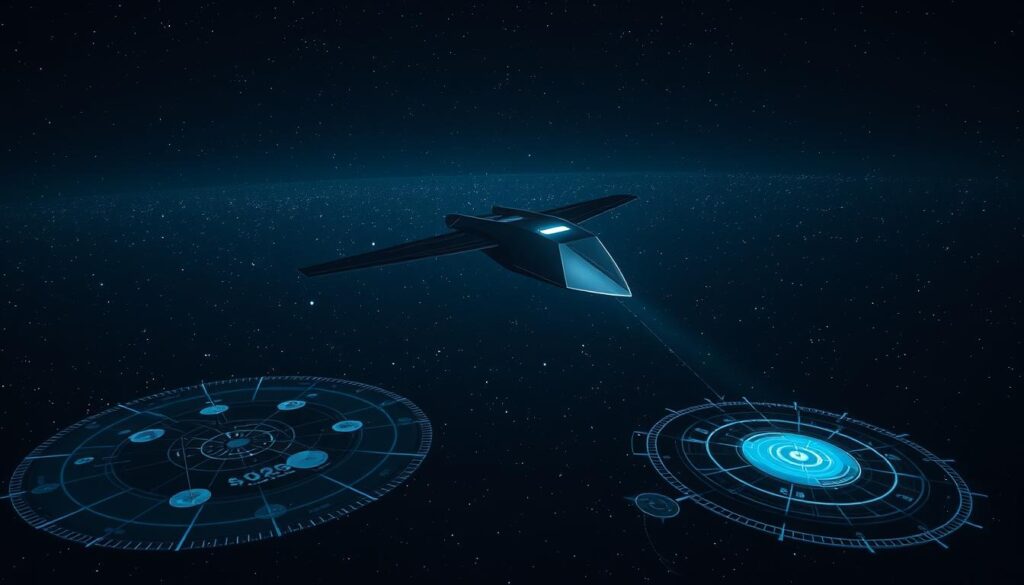
Crowdsourcing also plays a role. Apps like Sky360 let civilians report sightings with GPS-tagged photos. NOAA’s upcoming satellites will automatically flag anomalies, creating a global detection network.
NASA’s Ongoing Commitment to Transparency
In 2023, NASA pledged annual public briefings on findings. Their roadmap includes machine learning to identify patterns in decades of reports. “Open data builds trust,” said Dr. Thomas Zurbuchen, former head of science missions.
Private companies like SpaceX may contribute too. Shared satellite data could cross-reference sightings, adding layers of verification. As detection improves, so does our understanding of the skies’ enduring puzzles.
Conclusion: Separating Fact from Fiction
NASA’s 2023 study confirmed most sightings have ordinary explanations—weather balloons, drones, or optical illusions. Only a small fraction defy current understanding, warranting deeper research. This shift from speculation to science marks real progress.
Critical thinking is key. Sensational claims often crumble under scrutiny. Verified sources like NASA and NARA offer reliable data, unlike viral rumors. Transparency has improved since 2017, with agencies sharing more findings than ever.
Public engagement matters. Report sightings through official channels, not social media echo chambers. Collaborative science—not conspiracy theories—will solve these mysteries. The sky holds puzzles, but patience and evidence light the way forward.

